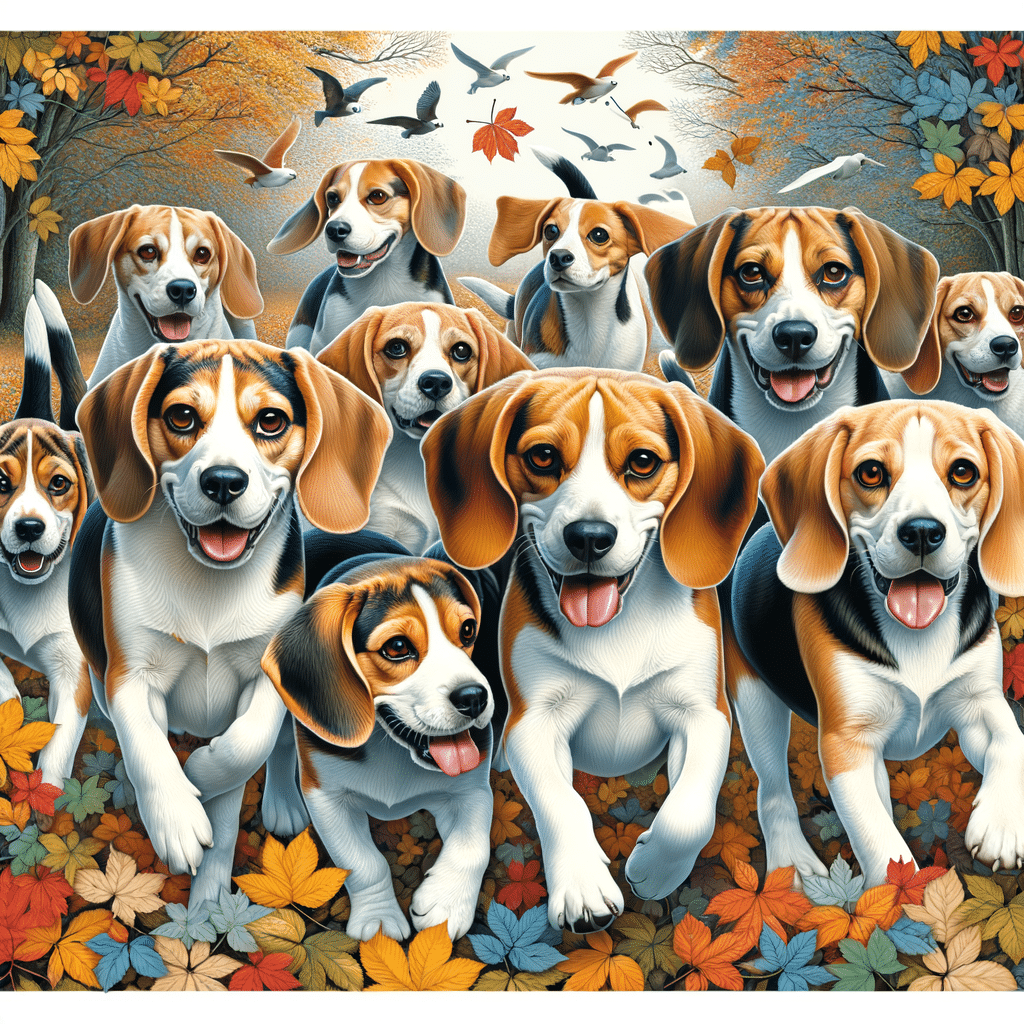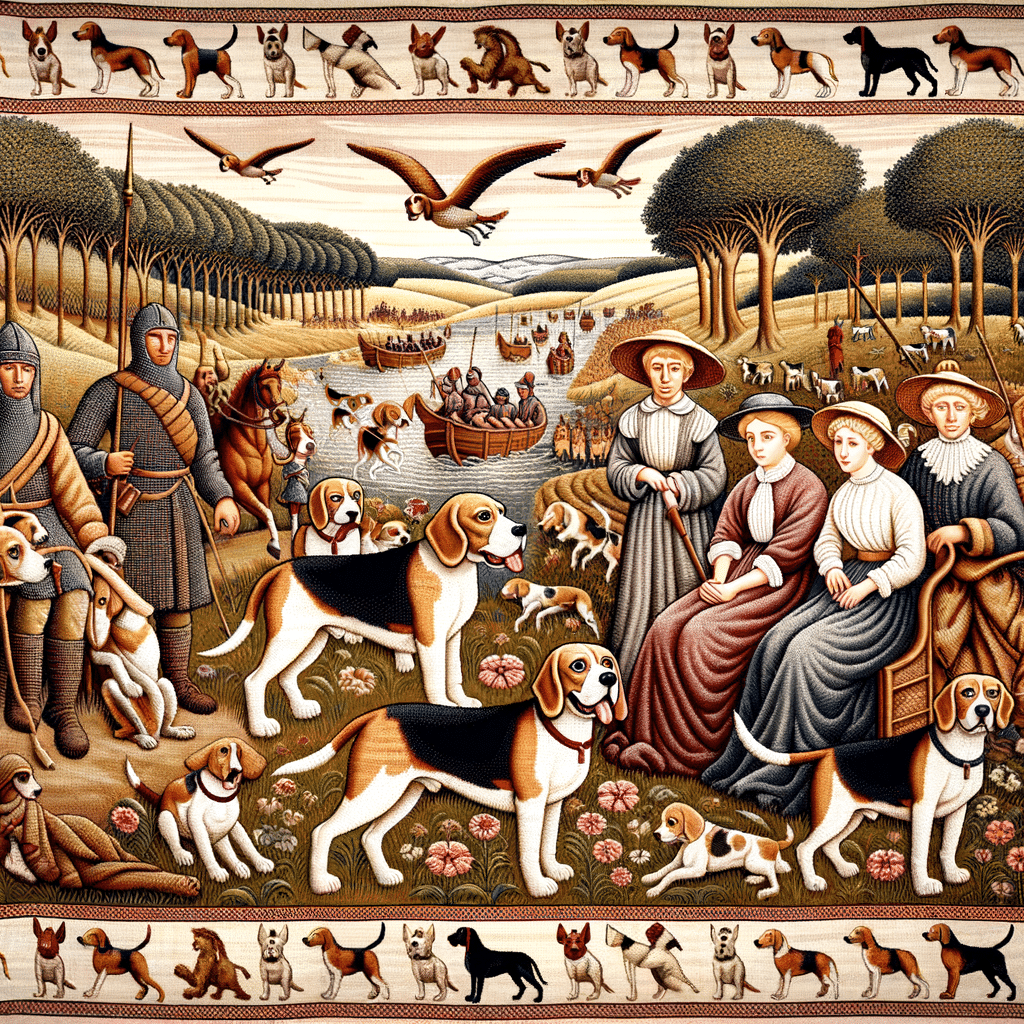Choosing between a beagle and an English bulldog involves considering numerous aspects of each breed to determine which may suit your situation. When considering the beagle vs. English bulldog breed overview, they are distinct with diverse backgrounds, shaping their physical characteristics, behaviors, and care needs.
In This Article
The beagle is known for its keen sense of smell and tracking instincts, making it a popular choice for hunting small game. In contrast, the English bulldog, with its distinctive muscular build and wrinkles, symbolizes courage and tenacity, often associated with British culture.3
While beagles and English bulldogs are both amiable and generally good with families, they have differences in their maintenance and lifestyle requirements. Active and energetic beagles require regular exercise to stay healthy and content.
On the other hand, English bulldogs are more laid-back and require less strenuous activity, but due to their physical build, they can be prone to specific health issues. Their care routines vary accordingly: beagles need space to explore and play, whereas bulldogs need special attention to skin folds and face cleanliness.
Consequently, understanding these breeds’ natures and care needs is imperative so you can give them a happy and comfortable living environment.
Highlights
- Both breeds suit families but have different activity levels and care requirements.
- Beagles are energetic and need ample exercise, while bulldogs are calmer but may have more health issues.
- Understanding each breed’s characteristics is crucial for meeting their health and environmental needs.
Breed Origins and History
Exploring the lineage of the beagle and the English bulldog reveals a history rooted in companionship and sport. Each breed carries a legacy that reflects its purpose and the culture from which it emerged.
Beagle Background
The beagle’s roots stretch back to ancient Greece, where small hounds hunted small game due to their keen sense of smell and tracking abilities. These dogs found their way to England via the Romans. The beagle evolved from the Talbot hound, believed to have been introduced by William the Conqueror in the 11th century.
Over centuries, beagles were fine-tuned as hunting companions, especially valued for their stamina and melodic bark. They were often referred to as “foot hounds” for their role in accompanying hunters on foot.
English Bulldog Ancestry
The English bulldog’s lineage is entwined with the blood sport of bullbaiting, which became an official sport in England in 1210. Dog articles suggest that the breed’s history can be correctly traced to this period. Bulldogs were bred for their formidable grip, strength, and tenacity, characteristics essential for the sport they were associated with.
Despite their early association with aggression, after bull baiting was outlawed in 1835, bulldogs were selectively bred to enhance their more docile and companionable nature. This left a legacy of the loyal, non-sporting family pets recognized today and sometimes considered designer dogs.
Physical Characteristics and Temperament
In assessing beagles and English bulldogs, it becomes evident that despite their common statuses as purebreds, each breed has unique physical characteristics and temperamental traits. They differ markedly in energy levels and physical build, with temperament qualities that appeal to various lifestyles and preferences.
Comparing Size and Weight
- Beagles: Typically classified as a small to medium breed, male beagles generally weigh between 22 and 25 pounds and stand about 14 to 16 inches tall at the shoulder. Female beagles are slightly smaller. As a puppy, this is a tiny dog.
- English bulldogs: English bulldogs are medium-sized dogs but are heavier due to their stockier build. Adult males weigh around 50 to 55 pounds and are 14 to 15 inches tall. Females are often lighter and marginally smaller.
Temperament and Personality Traits
Beagles are among the most popular dog breeds, known for their friendly and playful demeanor, making them well-suited for families with children. These dogs are affectionate and loving and enjoy the company of their humans. They require regular play and exercise to satisfy their high energy levels and curiosity.
English bulldogs, by contrast, showcase a calm and loyal temperament, often described as affectionate companions. While they are friendly and protective, bulldogs have relatively low energy levels. Their exercise needs are less intense and frequent compared to beagles.
Distinctive Features
Beagles
- Ears: Long, floppy ears that can catch and amplify scents.
- Voice: A distinctive howl-like bark, mainly when they detect exciting scents.
- Nose: A keen sense of smell, second only to the bloodhound in the scent hound category.
English Bulldogs
- Face: Wrinkled face with a pushed-in nose.
- Stature: A broad chest and muscular frame.
- Wrinkles: Skin folds requiring regular cleaning to maintain hygiene.
Health and Care Requirements
When considering the dog health and care of beagles and English bulldogs, it’s essential to understand their distinct needs. Both breeds have unique health issues, require differing exercise and activity levels, and have specific grooming requirements. This section details the care necessary to maintain their health and well-being.
Common Health Issues
Beagles and English bulldogs both are prone to certain hereditary health problems. Beagles may suffer from epilepsy, hip dysplasia, and beagle dwarfism. They can also experience Chinese beagle syndrome, which affects their muscle tone and causes eye problems like glaucoma and cherry eye.
On the other hand, English bulldogs face issues like brachycephalic syndrome, which results from their short snouts and can lead to breathing difficulties. They are also at risk for patellar luxation, hip dysplasia, and skin conditions such as demodectic mange.
Both breeds need to have regular veterinary check-ups to manage these issues effectively.
Exercise and Activity Levels
As a working dog, the beagle is known for its high energy levels and thus requires ample daily exercise to stay fit and prevent obesity. They typically need at least an hour of activity per day. This can be split between walks, playtime, and mental stimulation.
Bulldogs have lower energy levels but require regular exercise to maintain a healthy weight and avoid health complications. Daily short walks, play sessions with people, and dog toys are recommended. Due to their brachycephalic nature, bulldogs can overheat, so dog sports are not recommended.
Grooming and Shedding
Grooming requirements for beagles include regular brushing to manage their moderate shedding and to keep their coat clean. English bulldogs, while shedding regularly, need their skin folds cleaned to prevent infection. Both breeds require routine ear cleaning to prevent infections and nail trimming to avoid overgrowth and cracking.
Regular dental care is essential for both breeds to prevent dental diseases. The English bulldog breed group may also require attention to tear stains, while beagles can develop ear infections if their ears are not kept clean and dry.
Maintaining the health and care of beagles and English bulldogs requires a committed approach to managing their exercise needs, grooming, and monitoring common health issues. Proper care ensures these beloved companion dogs’ long, healthy, and happy lives.
Living Environment and Sociability
Selecting the right dog breed requires understanding how a pet fits into one’s living environment and their sociability. This section will outline the essential aspects for those considering a beagle or an English bulldog, focusing on their adaptability to living spaces and interactions with people and other pets.
Adaptation to Living Spaces
Beagles and English bulldogs differ significantly in their adaptation to different living environments. Beagles are known for their moderate energy levels and can adapt well to apartment living, provided they receive adequate exercise. Their size and social nature make them suitable for smaller spaces, although they appreciate a backyard to play in and explore. It is important to note that beagles may vocalize, which could be a consideration for apartment dwellers.
In contrast, English bulldogs are low-energy dogs well-suited to apartment life due to their lower exercise requirements. They have a gentle disposition, making them compatible with smaller living quarters. However, their tolerance for being left alone is lower than that of some other breeds, and thus, they may require more attention throughout the day.
Interaction with People and Pets
Beagles are affectionate, family-friendly, and social dogs that get along well with children, other dogs, and even cats if properly socialized. Their friendly demeanor and playful nature make them ideal companions for active families. They are also known to be stranger-friendly, often welcoming new people with enthusiasm.
English bulldogs are equally affectionate and loving and known for their sweet and gentle nature. They are kid-friendly and tend to be good-natured with other pets, though early socialization is key to fostering a peaceful cohabitation. However, they may show a different desire to socialize with strangers than beagles, sometimes appearing reserved or indifferent to new people.
Both breeds show a capacity for great affection towards their owners, thriving in an environment where they can form strong bonds with the people and pets they live with.
Frequently Asked Questions
Prospective pet owners often have several questions regarding characteristics, health, and maintenance when choosing between a beagle and an English bulldog. This section aims to address these common inquiries with clear and factual information.
What are the temperament differences between beagles and English bulldogs?
Beagles are known for their high energy levels and curious nature, making them lively and active companions. In contrast, English bulldogs typically showcase a more relaxed demeanor and can be more laid-back in their temperaments.
How do the sizes of beagles compare to those of English bulldogs?
Beagles are generally smaller dogs, with a height range of 13 to 16 inches and a weight range of 20 to 30 pounds. English bulldogs are stockier, with a more muscular build, and usually weigh between 40 and 50 pounds, despite a height similar to the beagle.
Which breed is known for being friendlier, beagles or English bulldogs?
Both beagles and English bulldogs are friendly and good with children, making each breed a suitable choice for your family pet. However, beagles may require careful attention around very small children due to their energetic nature.
Regarding health, which breed generally has fewer issues, beagles or English bulldogs?
Generally, beagles tend to have fewer health issues than English bulldogs. Bulldogs may be prone to more breed-specific health problems, such as respiratory issues.
Between beagles and English bulldogs, which breed is considered more loyal?
Loyalty is a trait both breeds have towards their owners. However, beagles may sometimes be more independently minded due to their strong hunting instincts, while English bulldogs often display steadfast loyalty and attachment to their families.
Is having a beagle as a pet or an English bulldog more challenging?
Both breeds have unique challenges. Due to their high energy, beagles can be more demanding in terms of exercise and mental stimulation, while English bulldogs’ health concerns and grooming needs due to their skin folds may pose a challenge for you as an owner.






